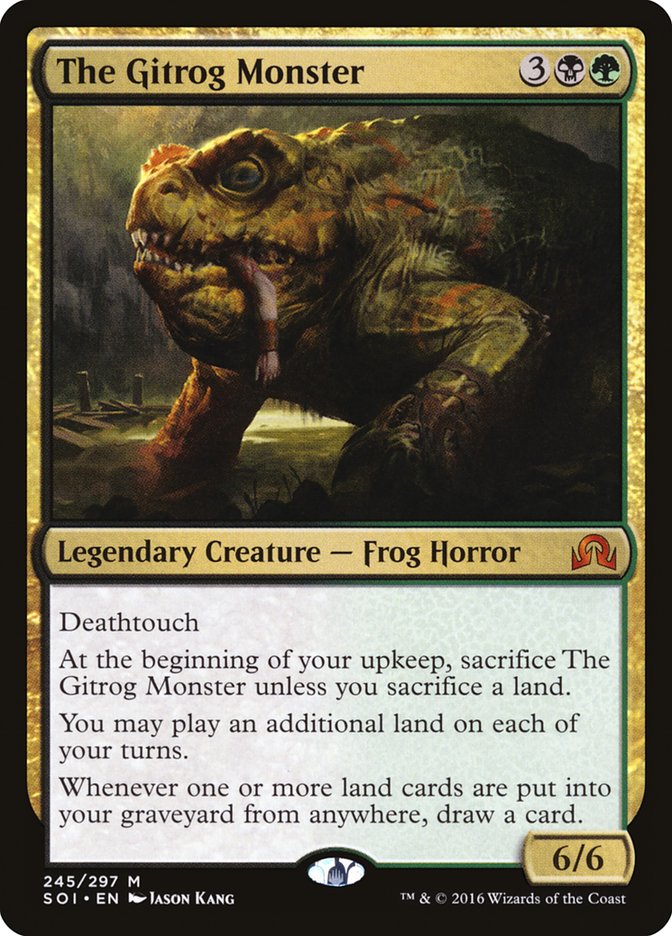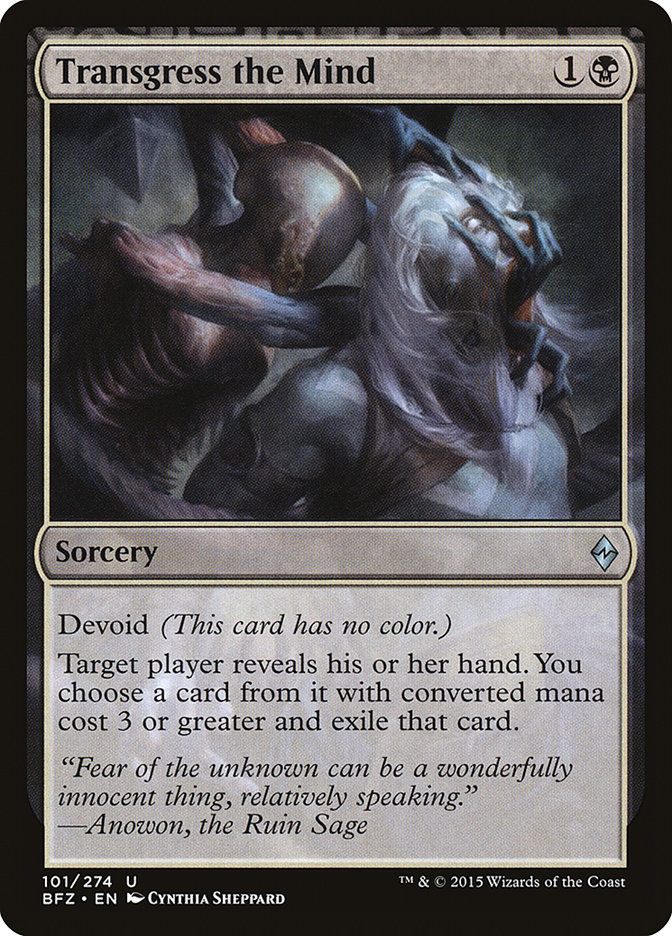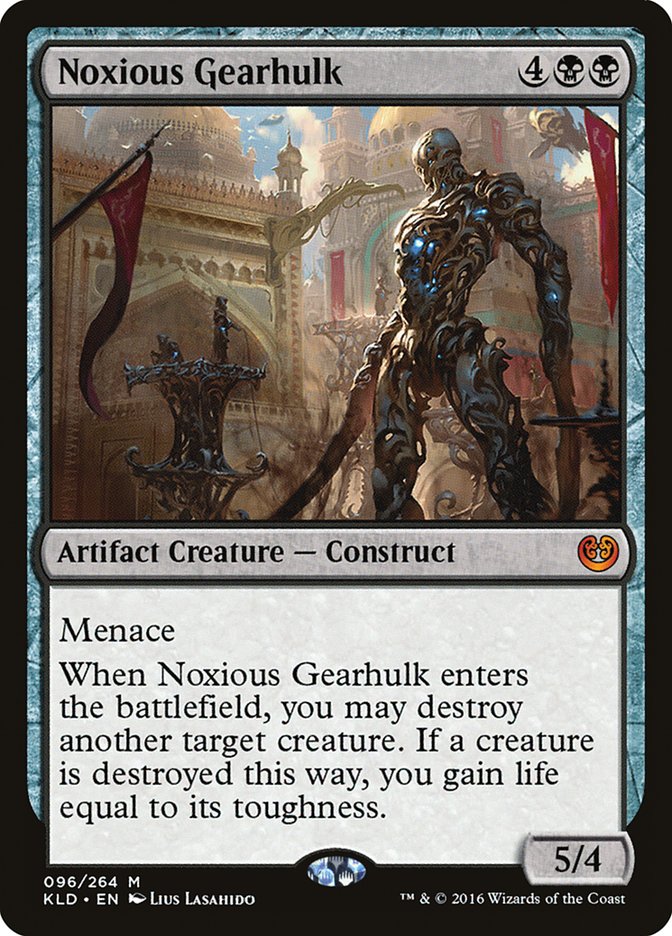I rejected B/G Delirium for Pro Tour Kaladesh not because I thought it was bad, but because I thought it wasn’t exemplary. I worked with two small teams in collaboration, Mad Apple and Hot Sauce, and collectively we ended up having players playing G/R Energy, Mardu Vehicles, U/R Control, and Bant Aggro.
Our group ended up largely split because, frankly, the format at that point didn’t have anything truly demanding it be played. One lone defector in our group, Nathan, played B/G Delirium, but this was largely because it was an all-around solid choice, not because it was particularly broken in some way. All of the other decks that our two teams chose felt like they had something unfair going on. B/G Delirium, on the other hand, just felt like it was a solid choice.
One of the biggest reasons I didn’t play B/G Delirium was that I was a little afraid of Aetherworks Marvel decks. Our own version wasn’t as good as I’d have liked, but once I’d put Contingency Plans into it, it was still very consistent. Any build that we’d try of a B/G Delirium list, in nearly any configuration, could beat a Marvel deck, but it often felt like it was just praying that the Marvel deck would stumble or fail.
Marvel ended up being the most popular deck of the Pro Tour, even though it did end up underperforming. Now, though, Marvel is largely gone, in large part because the deck struggles even in the most skilled hands.
This has certainly opened the door back up for B/G Delirium.
Of course, now we have a few results in from the deck:
Creatures (13)
- 2 Kalitas, Traitor of Ghet
- 4 Sylvan Advocate
- 3 Tireless Tracker
- 1 Emrakul, the Promised End
- 2 Ishkanah, Grafwidow
- 1 Noxious Gearhulk
Planeswalkers (3)
Lands (17)
Spells (27)

Creatures (14)
- 1 Pilgrim's Eye
- 1 Kalitas, Traitor of Ghet
- 3 Tireless Tracker
- 1 Emrakul, the Promised End
- 3 Ishkanah, Grafwidow
- 4 Grim Flayer
- 1 Noxious Gearhulk
Planeswalkers (3)
Lands (18)
Spells (25)

B/G Delirium clearly is back in the mix, and even though the “Delirium” side of B/G Delirium often comes out a little slowly versus the most aggressive decks, the overall form of the archetype still packs a punch.
Thus, it might be a surprise to you to hear me say that in the version of B/G I prefer for the coming weeks, it is only barely delirious.
The “Delirium” side of the equation can truly struggle when facing down decks that are designed to punish it. While we’re not there “today,” so to speak, given the success of Delirium decks recently, I expect to see an uptick on decks that can punish someone for playing a Vessel. Furthermore, in my testing for the last two Pro Tours – one of which I played B/G in – I just found that the most consistent build of the deck didn’t try to mess around. It just played a lot of copies of the very, very good cards.
Here is my current, post-double Standard GP weekend build of a “barely delirious” B/G Delirium deck.
Creatures (14)
- 2 Kalitas, Traitor of Ghet
- 4 Sylvan Advocate
- 3 Tireless Tracker
- 2 The Gitrog Monster
- 1 Ishkanah, Grafwidow
- 2 Noose Constrictor
Planeswalkers (6)
Lands (19)
Spells (21)

Just a few months back, my friend and regular collaborator, Ronny Serio, looked at an older list of mine and asked, “What if you just played more copies of your very good cards?” I took that to heart, and while I still end up with a minor tutor package, this deck is built to just play out simply and stably.
The removal package is pretty simple. Unlike Yichen Wang, I don’t have the ability to consistently get to delirium, so To the Slaughter is just less consistent for me. While I actually fairly loathe Ruinous Path in the current metagame, it is a necessary evil as a “third” pseudo-Murder that also has the upside of being able to kill a few cards Murder can’t, like Gideon, Ally of Zendikar. Dead Weight has gained a lot of value recently, but I could easily be persuaded to cut one from the maindeck if someone convinced me it wasn’t right in the moment.
Having consistent early drops is important. Again, like Yichen Wang, I just prefer the solid consistency of Sylvan Advocate. Noose Constrictor ended up making the list for several reasons, the biggest of which are its incredible ability to hold the fort in an early defensive game – especially when paired with six planeswalkers – and its ability to make crazy things happen in conjunction with The Gitrog Monster.
The cards in this group serve to grind out games or simply end them. Each represents basically the most copies of each that I’m willing to run right now. While it is possible that I could see upping the Kalitas count to three, I feel like such choices are better reserved for situations when you know that the card will be damningly powerful.
The Gitrog Monster is consistently one of the most surprising cards for people that see this list. In my initial attempts for Pro Tour Eldritch Moon, I saw a Jund list running the card and decided to try out a copy. I quickly went to two. Nearly everyone that has played the list expressed a similar dubiousness…and then ended up at two as well.
The card hits very, very hard. Closing out games can be a big deal, but The Gitrog Monster also ends up creating a mass of cards that matter and turns the excess lands (25 large) into valuable raw materials. The combos with Noose Constrictor; Liliana, the Last Hope; and Evolving Wilds are a little bit of gravy, but even without them, this card is just great.
Tireless Tracker as a four-of after sideboarding is the other card that gets commentary. Simply put, this card is just ludicrous in any game that grinds out. I could see running four in the maindeck if the metagame slowed up a bit.
Nissa, Vital Force entered the deck as a one-of during some initial testing. I found quickly that the card would be a critical part of the game in three ways. First, it would sometimes put so much pressure on the opponent that the game would just end. Second, sometimes it would send the game into a standstill and just turn into a one-way Howling Mine that couldn’t be dealt with by another deck on the grind. Finally, it could immediately start a grind game by returning an important resource for a long fight. I almost want a third copy, but the other five-drops in the deck take precedence.
This deck is clearly learning on Oath of Nissa rather than Traverse the Ulvenwald for a lot of reasons. First of all, the deck isn’t doing the dedicated delirium work necessary to make Traverse the Ulvenwald a scary card. Rather, the deck is trying to consistently drop plays like turn 2 two-drop and turn 3 three-drop. Oath of Nissa is a much more critical part of a plan like this.
Traverse the Ulvenwald is still present in the deck, though. At Pro Tour Eldritch Moon, I’d initially wanted the 3/2 split that I’m running in this deck, but I ended up feeling like I needed to cut into it to make room for the action spells I most liked. I ended up at 2/1 on Oath/Traverse because you can still get value out of Traverse beyond a simple land search. It’s gratifying to go back to more of each, like I initially preferred.
The single Ishkanah, Grafwidow is a part of the legacy of that choice. Many of my teammates wanted an Ishkanah in the deck, but they wanted to cut The Gitrog Monster to do it. After the PT, while I hadn’t cut the Big Frog versus anyone, I’d also put in Ishkanah versus every deck. Even with only a very tiny bit of tutoring, having Ishkanah in the deck was just a huge option. Unlike Emrakul, the Promised End, Ishkanah was reasonable to put onto the battlefield without going for graveyard-filling. Noose Constrictor and the enchantment count do make it reasonable to be able to get to delirium in many mid-games, though you won’t hit it every time. Even so, it is still worth the time.
One Transgress the Mind might seem like an odd number, but it is basically the most I feel safe running. Shota Yasooka’s winning deck at Pro Tour Kaladesh hammers home the real worry of diminishing returns from a card which can, versus the aggressive decks, be a part of the script of a game you lose. It helps to lower the curve by playing this card, though I wouldn’t be opposed to swapping it back into the board for a maindeck fourth Tireless Tracker if you are squeamish about it.
The sideboard is mostly running extra copies of analogs to the cards that are already in the deck, either in the forms of supplementary removal or cards that can fulfill similar roles. The three big exceptions to this are the copious discard and two of the creatures.
The discard package is for fighting the long fights against any old deck. Especially important, though, is the trio of Pick the Brain, a huge part of putting together a fight against opposing Emrakul, the Promised Ends in B/G Delirium. The cards are also good against anything with a slow grind, but you don’t want to be on the wrong side of a 13/13 Mindslaver.
Our own Emrakul, the Promised End is also a part of the package. While this deck isn’t nearly as good as using the card as a traditional B/G Delirium deck, even so, the card can serve the same purpose in a very long game. I’ve even used Nissa, Vital Force to bring back Emrakul for the win, though it is usually cast after Liliana, the Last Hope; Traverse the Ulvenwald; or Oath of Nissa brings it to hand.
Noxious Gearhulk is not a card that I like in a ton of matchups, but it serves as a powerful grinding card and also is another anti-Emrakul card. It’s not uncommon to have out a Liliana versus an Emrakul and simply have your dead Gearhulk serve as a “permanent” answer to Emrakul.
The biggest reason I love this deck is that it is a true pleasure playing this deck against W/U Flash. Even more so that the traditional B/G Delirium decks, B/G Barely Delirious just has more and better weapons for the fight. It is much less likely to get overrun by a tempo game, and it is still incredibly powerful in a protracted fight.
If you live in a weird world where Aetherworks Marvel is a player, I wouldn’t recommend this deck, but for the rest of you, I highly recommend trying out being only barely delirious. I think you’ll find you like it!







